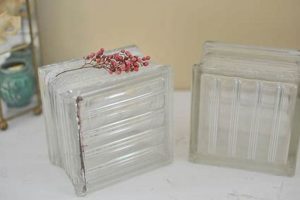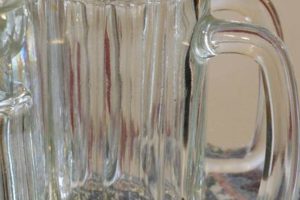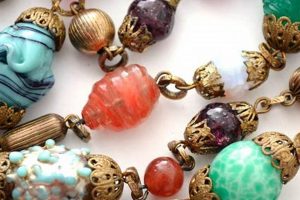Objects crafted in France, during a prior era, specifically designed for the consumption of wine, are the subject of this discussion. These stemmed vessels often exhibit characteristics representative of the periods in which they were manufactured, including unique shapes, decorative elements, and manufacturing techniques. For instance, a piece from the Art Deco period may display geometric patterns and streamlined forms, while an older specimen might feature hand-blown glass with subtle imperfections indicative of its age.
Their significance extends beyond mere functionality. They provide a tangible connection to past eras, reflecting the aesthetic sensibilities and social customs of their time. Collecting these items provides insights into glassmaking traditions and historical dining practices. Furthermore, using these period-specific vessels enhances the sensory experience of wine consumption, potentially influencing perceived aromas and flavors due to variations in bowl shape and glass thickness.
The following sections delve into specific aspects of these historic pieces, covering identification methods, prevalent styles from different decades, and advice for acquiring and preserving these delicate artifacts. Understanding these facets helps appreciate and preserve these relics of fine dining.
Guidance on Acquiring and Maintaining Historic French Wine Vessels
The subsequent recommendations address the acquisition, authentication, and preservation of antique French wine receptacles. Adhering to these guidelines contributes to the responsible handling and appreciation of these historical items.
Tip 1: Examine Markings and Signatures: Authentic examples often possess makers’ marks or signatures etched or molded into the glass. Research known signatures and hallmarks to verify authenticity and determine the origin and age of the piece. Consult reference materials and expert opinions when available.
Tip 2: Assess Glass Quality and Consistency: Earlier manufacturing techniques resulted in subtle variations in glass thickness and clarity. Inclusions, bubbles, or minor imperfections are not necessarily indicative of a reproduction, but rather a characteristic of the period. Excessive uniformity or flawlessness, however, may suggest modern production.
Tip 3: Evaluate the Style and Design: Familiarize oneself with prevalent design aesthetics across different eras in French glassmaking. Research the stylistic characteristics of Art Nouveau, Art Deco, and mid-century modern examples. Compare the piece in question to documented examples from reputable sources.
Tip 4: Consider the Condition and Restoration: While minor wear is expected in antique items, significant damage compromises value and structural integrity. Evaluate the extent of any chips, cracks, or repairs. Seek professional restoration for valuable pieces, ensuring that any repairs are reversible and historically sensitive.
Tip 5: Implement Proper Cleaning Techniques: Harsh detergents and abrasive cleaners can damage delicate surfaces. Use a mild, pH-neutral soap and lukewarm water for cleaning. Avoid subjecting the glass to extreme temperature changes. Hand-wash only and dry with a soft, lint-free cloth.
Tip 6: Ensure Secure Storage: Store the glasses in a display cabinet or on shelves lined with padding to prevent accidental breakage. Consider individual storage sleeves or dividers to prevent contact and scratching between pieces. Maintain a stable temperature and humidity to minimize the risk of damage.
Tip 7: Document Provenance When Possible: Retain any available information regarding the history of ownership, including purchase receipts, appraisals, or family records. Documented provenance enhances the value and historical significance of the object.
These measures ensure the longevity and preservation of these artifacts, offering both aesthetic enjoyment and a connection to historical craftsmanship. Preserving these historic artifacts will maintain its historical value.
The subsequent section provides detailed descriptions of prominent styles across different historical periods.
1. Glassblowing Techniques and Antique French Wine Receptacles
The examination of manufacturing processes is integral to understanding and authenticating antique French wine vessels. Glassblowing techniques, which fundamentally shaped the characteristics of these objects, offer insights into their age, origin, and value.
- Free-Blown Glass
Free-blowing, employed extensively before the widespread adoption of molds, involves shaping molten glass solely through blowing and manipulation with tools. This process often results in subtle irregularities in thickness, form, and surface texture. Such imperfections, absent in mass-produced items, are characteristic of earlier, hand-crafted specimens. Examining the vessel for minute variations serves as a preliminary method for assessing age and authenticity.
- Mold-Blown Glass
The introduction of molds enabled the creation of more uniform shapes and intricate patterns. Vintage French glassmakers utilized various mold techniques, including dip molds for basic forms and full-size molds for complex designs. The presence of seam lines, indicative of mold construction, provides information about the manufacturing process and potential period of origin. However, the absence of prominent seams does not necessarily exclude mold-blowing; skilled artisans could minimize their visibility.
- Gathering and Tool Marks
The process of gathering molten glass from the furnace leaves distinct marks on the finished piece. The pontil mark, where the pontil rod was attached to the base, is a common feature on hand-blown glass. Additionally, evidence of tool manipulation, such as slight indentations or striations, reflects the artisan’s handiwork. These details, often overlooked, offer valuable clues about the manufacturing techniques employed and can aid in differentiating hand-crafted pieces from machine-made reproductions.
- Glass Composition and Clarity
The composition of the glass itself provides insights into the era of production. Earlier glass formulations often contained impurities, resulting in variations in color and clarity. The presence of minute bubbles or inclusions, while considered imperfections by modern standards, are common characteristics of historical glass. Analyzing glass clarity and color can assist in dating pieces and discerning the type of glass used, such as lead crystal or soda-lime glass, each associated with particular periods and styles.
These aspects of glassblowing, examined in conjunction with stylistic elements and historical context, offer a comprehensive framework for appreciating the craftsmanship and historical significance embedded within these artifacts. Analyzing these characteristics contributes to a more thorough understanding of this delicate form of art.
2. Stemware Shapes
The form of a receptacle designed for wine service directly influences the sensory experience. With these historic examples from France, the curvature of the bowl, the height of the stem, and the diameter of the rim are not merely aesthetic choices; they are functional elements that affect the aroma, temperature, and delivery of the wine to the palate. A narrow, flute-like shape, common in the service of Champagne, restricts the surface area of the liquid, preserving effervescence. Conversely, a broader bowl, as found in Burgundy glasses, allows for greater aeration, releasing complex aromas. The stem provides a means of holding the glass without warming the contents, while the rim’s thinness or thickness impacts the perceived texture of the wine.
Specific forms gained popularity during particular periods in France, reflecting both evolving winemaking styles and prevailing social customs. The shallow coupe, favored during the early 20th century, was associated with celebratory occasions and the service of lighter, sweeter wines. The tulip-shaped glass, gaining prominence later in the century, offered a more focused presentation of aromas and was often paired with more complex vintages. Identifying a glass’s shape, therefore, offers a clue to its age and intended purpose. Consider, for example, a set of vintage Baccarat stemware with long, slender stems and a flared lip; this form would suggest a mid-20th century design intended for serving white wines at a formal dinner. Conversely, a squat, thick-walled glass with minimal stem might indicate a casual bistro setting and a more rustic style of wine consumption.
An appreciation for the relationship between stemware shape and the nuances of wine consumption enhances the experience for both the collector and the consumer. Understanding that each shape serves a distinct purpose provides a richer appreciation of the historical and cultural context. It also allows for a more informed selection of glassware to complement specific wines. While subjective preferences play a role, recognizing these functional design elements elevates the act of drinking wine from a simple act of consumption to an engagement with tradition. However, knowledge of shape alone is not enough to determine authenticity and should be coupled with the study of maker’s marks and construction techniques.
3. Era Aesthetics
The aesthetic sensibilities of different eras profoundly influenced the design and production of French wine vessels. Examining the stylistic elements characteristic of distinct periods provides crucial insights into dating, authenticating, and appreciating historic glassware. These aesthetic variations reflect broader cultural trends, artistic movements, and technological advancements prevalent at the time of manufacture.
- Art Nouveau (circa 1890-1910)
Characterized by flowing, organic lines and motifs inspired by nature, Art Nouveau glass displays sinuous curves, floral patterns, and depictions of insects or mythical creatures. Examples frequently incorporate iridescent finishes and hand-painted enamel details. These elements aimed to evoke a sense of luxury and refinement, reflecting the era’s fascination with natural beauty. The glasses reflect these characteristics.
- Art Deco (circa 1920-1930s)
In stark contrast to Art Nouveau, Art Deco embraced geometric forms, streamlined designs, and a celebration of industrial materials. Wine glasses from this period often feature stepped patterns, angular shapes, and bold color contrasts. Materials such as chrome and black glass became popular, reflecting the era’s emphasis on modernity and technological progress. These shapes are more geometrical.
- Mid-Century Modern (circa 1940s-1960s)
Mid-Century Modern designs favored clean lines, functional forms, and a minimalist aesthetic. French stemware from this era often features simple, elegant shapes with a focus on practicality and ease of use. Colors were typically muted, and decorations were kept to a minimum, reflecting a broader cultural shift towards simplicity and informality. Clear glass was prefered during this time.
- Revival and Eclectic Styles (Late 20th Century)
The late 20th century witnessed a resurgence of interest in historical styles, alongside a more eclectic approach to design. Some French glassmakers revisited Art Deco or Art Nouveau motifs, while others experimented with new forms and materials. This period is marked by its diversity, with both reproductions of earlier designs and innovative creations reflecting contemporary tastes.
These era-specific stylistic elements, when considered in conjunction with manufacturing techniques and maker’s marks, provide a valuable framework for understanding the history and cultural context of vintage wine vessels from France. Discerning aesthetic elements helps to refine historical perspective. Such refinement makes the art more meaningful and easier to study.
4. Maker Marks
The presence and interpretation of manufacturer’s marks represent a critical element in establishing the provenance and value of antique French wine receptacles. These marks, typically etched, engraved, or molded into the glass, serve as signatures of the producing company or artisan. Their presence indicates the objects origin, while their absence can suggest either a lack of authentication or, less commonly, production by a workshop that did not routinely mark its wares. For instance, a “Baccarat” mark on the base of a stemmed piece confirms its production by the renowned French glassmaker, directly influencing its market value and historical significance. However, the mark alone does not guarantee authenticity; careful examination of the mark’s style, size, and placement, compared with known examples, is necessary to mitigate the risk of forgery.
The styles of these marks have evolved over time. Early marks might consist of simple initials or symbols, while later marks incorporated more elaborate designs, company logos, or even the names of specific designers. Researching the historical usage of these marks within the French glassmaking industry allows for a more precise dating of the object. For example, a Daum Nancy glass bearing an enameled signature incorporating the Cross of Lorraine suggests production between 1890 and 1914, when that particular mark was in use. The deterioration or alteration of a mark can also provide clues about the item’s history; a partially obscured mark may indicate wear from handling or attempts to remove it, factors that can affect the piece’s overall condition and collectability.
In conclusion, maker’s marks provide invaluable data for understanding historic French wine containers. Accurate identification necessitates meticulous study, involving comparisons with established references and expert consultations. While the presence of a mark significantly enhances the provenance and potential value of these objects, its proper interpretation forms an essential component of responsible acquisition and preservation, promoting authenticity in historical wine vessels.
5. Wine Service History
The historical context of wine service significantly influences the design, use, and cultural perception of vintage French wine vessels. The evolution of dining customs, social etiquette, and wine production techniques has shaped the form and function of these objects, providing valuable insights into their significance.
- Evolution of Glassware Styles
Changes in wine service rituals dictated the evolution of glassware shapes and sizes. The transition from communal drinking vessels to individual glasses, for example, reflected a growing emphasis on hygiene and personal space in dining practices. The shallow coupe, popular in the early 20th century, mirrored the fashion for celebratory drinks like Champagne served at large gatherings. The rise of more specialized forms, such as the tulip glass for aromatic white wines, coincided with a growing appreciation for the nuances of wine appreciation.
- Social Class and Etiquette
Wine service has always been intertwined with social status and dining etiquette. In aristocratic settings, elaborate glassware, often made of fine crystal and adorned with intricate engravings, served as a symbol of wealth and refinement. The correct use of specific glasses for different types of wine reflected a sophisticated understanding of dining protocols. The ownership and display of valuable glassware were therefore integral to social standing.
- Regional Variations in Service
Distinct regional traditions in France influenced the style of glassware and the manner of wine presentation. In Burgundy, for example, large, balloon-shaped glasses were favored to allow for the full expression of the region’s complex red wines. In Alsace, taller, slender glasses were often used to showcase the aromatic white wines of the area. These regional variations reflect the unique characteristics of local wines and the corresponding adaptations in service practices.
- Impact of Technological Advancements
Innovations in glassmaking technology played a crucial role in shaping the design and availability of wine vessels. The development of lead crystal, for instance, allowed for the production of thinner, more brilliant glasses that enhanced the visual appeal of wine. The introduction of mass-production techniques made glassware more accessible to a wider segment of the population, leading to changes in dining customs and the democratization of wine consumption. These advancements increased the production of wine vessels.
The evolution of wine service history offers a crucial lens through which to appreciate the aesthetic and functional characteristics of antique French wine glasses. Understanding the historical context enhances the value and cultural relevance of these objects, providing a richer appreciation of their significance in the broader narrative of French dining and social customs.
Frequently Asked Questions
The following addresses common inquiries regarding the identification, valuation, and care of antique French glassware designed for wine consumption. These answers aim to provide clear and concise information for collectors and enthusiasts.
Question 1: How does one differentiate between genuine antique examples and modern reproductions?
Authenticity verification involves multiple factors. Examination of manufacturing techniques, presence of maker’s marks, stylistic consistency with the purported era of production, and evaluation of glass composition are crucial. Consultation with a qualified expert is recommended for high-value items.
Question 2: What are the most significant factors influencing the valuation of these items?
Rarity, condition, provenance, maker, and aesthetic appeal are the primary determinants of value. Highly sought-after makers, pristine condition, documented history of ownership, and exceptional designs command higher prices. Scarcity of a design is also a factor.
Question 3: What is the appropriate method for cleaning delicate antique glassware?
Gentle hand-washing with a mild, pH-neutral detergent in lukewarm water is recommended. Abrasive cleaners, harsh chemicals, and dishwashers should be avoided to prevent damage to the glass surface. Drying with a soft, lint-free cloth minimizes water spots.
Question 4: Are minor imperfections detrimental to the value of antique examples?
Minor imperfections, such as small bubbles or slight variations in glass thickness, are often characteristic of hand-blown glass and do not necessarily detract significantly from value. However, significant damage, such as cracks or large chips, negatively impacts the piece’s worth.
Question 5: How should they be stored to prevent damage?
Storage in a climate-controlled environment, away from direct sunlight and extreme temperature fluctuations, is ideal. Individual padding or dividers between pieces prevent scratching and breakage. Display cabinets or shelves with secure supports minimize the risk of accidental falls.
Question 6: Where can one find reliable resources for researching identification marks and historical information?
Specialized books on antique glassware, online databases of maker’s marks, museum collections, and auction house catalogs provide valuable resources. Consultation with antique appraisers and glass historians offers expert insights.
The information outlined above provides a basic understanding of the key considerations when dealing with vintage French wine receptacles. Responsible acquisition, care, and preservation ensure the longevity and appreciation of these historical objects.
The following section offers a glossary of relevant terms related to glassware and its historical production.
Conclusion
The preceding exploration demonstrates the multifaceted nature of the subject matter. These historical objects represent not only vessels for wine consumption but also tangible links to past eras, artistic movements, and evolving social customs. Identification, authentication, and preservation require a nuanced understanding of glassmaking techniques, stylistic trends, and historical context. Accurate assessment necessitates careful examination of manufacturer’s marks, construction methods, and prevalent design aesthetics. The subject transcends mere appreciation of craftsmanship; it involves engagement with cultural and historical narratives embedded within these fragile artifacts.
Continued research and diligent preservation efforts are essential to safeguard these relics of fine dining. Further investigation into the provenance, historical usage, and regional variations within the domain of French wine vessels will contribute to a more comprehensive understanding of their cultural significance. A continued dedication to responsible collecting and conservation will ensure these historical artifacts remain accessible for future generations, allowing for a continued connection to the past through these tangible objects.







